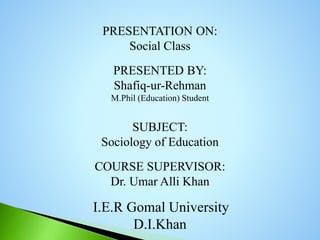
SOCIAL CLASS
- 1. PRESENTATION ON: Social Class PRESENTED BY: Shafiq-ur-Rehman M.Phil (Education) Student SUBJECT: Sociology of Education COURSE SUPERVISOR: Dr. Umar Alli Khan I.E.R Gomal University D.I.Khan
- 2. “We define social classes as groups of families more or less equal in rank and differentiated from other families above or below them with regard to characteristics such as occupation, income, wealth, and prestige”
- 3. “Birds of a feather flock together” Social class – a status hierarchy by which groups and individuals are classified on the basis of esteem (regard, respect) and prestige (reputation, influence derived from achievements). – American Marketing Association The different lifestyles of social classes lead to different benefits being sought
- 4. Members of the same social class tend to share common values, beliefs, and behaviors that unite them (as opposed to simple demographics). Common factors used to place people into different social classes: occupation, source of income, possessions, associations with others, and level of influence.
- 5. What a person does for a living. It is an indicator of other signs of class membership: income, personal associations, and status. Further, class assumptions within an occupation may be based on performance level.
- 6. Level of income is not by itself a good indicator of class. Income source along with occupation may help us determine whether two individuals that have the same income belong in the same class: investments, inheritance, old wealth, etc. Does a professional athlete making $20 million belong in the same social class with a physician making $150,000
- 7. Consumption patterns and interaction networks are inherently linked. People tend to associate with others that share the same tastes and recreational activities. Class consciousness – sense of belonging to a certain class is reinforced by our associations. The higher our class the more class conscious we are. ◦ A mechanic wins a $50 million in the lottery…will his/her social class change?
- 8. Membership in a higher class generally leads to greater influence within the workplace, organizations, and society as a whole. The more responsibility one has the greater the influence s/he can exert on others.
- 9. The study of social class has its origin in Western Philosophy. Philosophers during this period realized that wealth, power, and prestige were not equally distributed in society. They understood that this unequal distribution of resources reflected a social hierarchy composed of families with different class interests based on the amount of wealth, power, and prestige that they controlled.
- 10. Marx argued that social classes are characterized by their relationship to the means of production. Marx identified two classes: ◦ The bourgeoisie, or the capitalist class, who own the means of production (e.g., factories). ◦ The proletariat, or the working class, composed of those individuals who must sell their labor to members of the bourgeoisie for a wage in order to survive.
- 11. Like Marx, Weber made the distinction between those who owned property and those who did not. In contrast to Marx, Weber allowed for more than two distinct social classes and even suggested that “the proletariat were really a highly differentiated group” (p.7). Social class: “group who share the same economically shaped life chances” (p.8). ◦ An objective economic fact
- 12. 1. Economic basis a. Occupation b. Wealth c. Income d. Poverty 2. Social Basis e. Prestige f. Association g. Socialization h. Social mobility 3. Political Implications i. Power j. Class Consciousness
- 13. The five indicators may be used singly or in combination to establish an individual’s class status. Methods normally used to classify people into social classes include (all are subjective): ◦ The reputational approach ◦ The subjective approach ◦ Objective approaches: Single-item measures Multiple-item measures
- 14. A five-class hierarchy ◦ Upper class (Upper – “Landed gentry”, Lower “New money”) ◦ Upper-middle class (Professional class, Cultural protectors) ◦ Lower-middle class (Moral compass of society, “Typical American”) ◦ Upper-lower class (“Monotonous” existence) ◦ Lower-lower class
- 15. Upper class (Upper – “Landed gentry”, Lower “New money”) Attend elite schools, old/new money, in/not in the “register” Upper-middle class (Professional class, Cultural protectors) Professionals, independent businesspeople, corporate executives Lower-middle class (Moral compass of society, “Typical American”) Salespeople, clerical workers, supervisors, construction contractors, small retail store owners, “white collar” Social Class Types
- 16. Upper-lower class (“Monotonous” existence) Skilled and semi-skilled blue-collar workers, narrow existence Lower-lower class Lower blue-collar workers, the unemployed, families on welfare, and unskilled workers Social Class Types
- 17. Social class is an important source of beliefs, values, and behaviors Different social classes value education differently. Attitudes toward family life, raising children, the role of women, etc. vary from class to class. People in various social classes exhibit markedly different lifestyles
- 18. Lower-class people are less likely to subscribe to newspapers than are members of the middle class. Choice of magazine is likely tied to education and reading ability Lower-middle class – Reader’s Digest, Ladies Home Journal Upper-middle class – Time, SI, The New Yorker, etc. Broadcast media choice also varies by social class Lower-middle class – more responsive to audiovisual forms of communication
- 19. Lower-status consumers are more receptive to advertising that depicts activity, ongoing work and life, expressions of energy, etc. Upper-middle class consumers are more critical of advertising, suspicious of emotional appeals and skeptical of claims
- 20. Lower-class women are the most “impulsive” about shopping. Outlet choice varies by social class (class match very important) Upper-lower class women are likely to respond to promotions offering coupons or other special inducements Bowling, TV, and bingo are favorite lower-class leisure pursuits Most activities enjoyed by middle- and upper-class people are less time consuming than lower-class choices.
